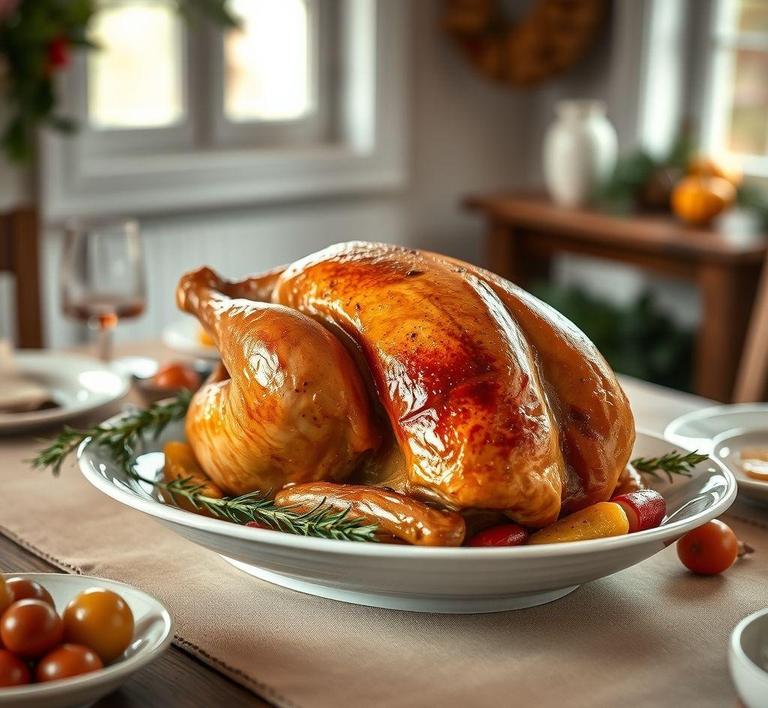So, you’ve got half a turkey left over and you’re wondering whether it’s okay to refreeze it, right? Well, you’re in luck! In this guide, we’re diving into everything you need to know about safely refreezing that leftover turkey. Whether it’s from a big holiday feast or just an extra-large grocery haul, we’ll walk you through the best practices to keep that turkey fresh, juicy, and totally safe for your next meal. No one wants to risk food safety, so let’s make sure you handle your half-turkey like a pro!
Can You Refreeze Half Turkey?

When it comes to food safety, turkey often presents a bit of a dilemma, especially when you’re considering whether or not it’s safe to refreeze it. If you’ve cooked or thawed half of a turkey, the question arises: Can you refreeze it? The short answer is yes, you can refreeze half of a turkey, but there are important factors to consider to ensure both safety and quality.
Turkey, like most meats, follows the basic guidelines for freezing and thawing. When a turkey has been thawed in the refrigerator and kept at a consistent, safe temperature (below 40°F or 4°C), you can technically refreeze it. However, the process is not without its nuances, which is why understanding the conditions is key to avoiding any foodborne illnesses or unpleasant changes in taste and texture.
It’s crucial to note that the turkey must not have been left at room temperature for too long (no more than 2 hours, or 1 hour if it’s over 90°F or 32°C), as bacteria can multiply rapidly. Additionally, if the turkey has already been cooked or partially cooked, the rules for safe refreezing might differ slightly, depending on how it was handled.
How To Refreeze Half Turkey?
Refreezing half of a turkey is a process that requires some specific steps to preserve its safety and quality. Whether your turkey is raw, cooked, or partially thawed, here’s how to do it properly.
1. Ensure Safety And Proper Storage Temperature
Before anything else, confirm that your turkey has been stored at the correct temperature throughout its time in the refrigerator or freezer. If the turkey has been sitting at room temperature for more than 2 hours, or 1 hour in hotter conditions, it’s best to discard it. If it’s been kept properly chilled at or below 40°F, you’re good to move forward.
2. Properly Package The Turkey
When refreezing half a turkey, make sure you package it well to minimize the risk of freezer burn, which can negatively affect texture and flavor. You can wrap the turkey tightly in plastic wrap or aluminum foil, ensuring it’s airtight. For added protection, especially if you’re planning to refreeze it for an extended period, place it in a freezer-safe, resealable bag or an airtight container.
If you’ve cooked the turkey, allow it to cool to room temperature first-never refreeze hot food. You can speed up the cooling process by cutting the turkey into smaller pieces. Once it has cooled, it’s ready for packaging and refreezing.
3. Label And Date
Make sure to label your turkey with the date of freezing. Even though turkey can stay in the freezer for a while, it’s always a good idea to keep track of when it went in. The general recommendation is that frozen raw turkey should be used within 6 months for the best quality, while cooked turkey can be safely stored in the freezer for 4-6 months.
4. Refreeze Quickly
Once the turkey is properly packaged, place it back in the freezer as quickly as possible. Avoid refreezing it in small portions that may thaw faster, leading to uneven freezing and potential quality loss.
Quality Impact
While refreezing half of a turkey is generally safe, it does come with some potential downsides, primarily when it comes to quality. The main factors that influence the quality of refrozen turkey are moisture loss, texture changes, and flavor deterioration.
Moisture Loss
Turkey meat, especially the white meat, has a relatively low fat content, which means it can dry out quickly when frozen and thawed repeatedly. Each time you freeze and thaw turkey, ice crystals form and can rupture the meat’s cellular structure, leading to a loss of moisture. This can make the turkey dry and tougher when reheated.
Texture And Tenderness
With each freeze-thaw cycle, the muscle fibers of the turkey become more damaged. This results in a noticeable change in texture, where the meat may become stringy or chewy. When you refreeze a cooked turkey, the texture can be even more impacted, as the cooking process already alters the muscle structure.
Flavor Changes
The flavor of turkey, especially cooked turkey, can degrade slightly after being refrozen. This happens due to oxidation and the breakdown of certain compounds during the freezing process. The longer the turkey is stored in the freezer, the more pronounced these flavor changes can become. While the turkey may still be safe to eat after refreezing, it may lose some of its fresh, juicy taste.
Freezer Burn
Another risk that affects quality is freezer burn, a condition that occurs when air comes into contact with the meat’s surface, drying it out and causing discoloration. Though freezer-burned turkey is still safe to eat, it may have a leathery texture and unpleasant flavor.
Refreezing half of a turkey is entirely feasible, but it’s important to approach it with careful attention to safety and quality. You must ensure that the turkey has been properly thawed and hasn’t been left out at room temperature for too long. Packaging the turkey securely and ensuring it’s stored at a consistent, safe temperature are key to maintaining food safety.
That said, while the turkey will likely remain safe to eat if stored correctly, its quality can be affected by moisture loss, changes in texture, and potential flavor degradation. The more times you freeze and thaw the meat, the more noticeable these impacts will be. For the best results, limit the number of times you freeze turkey and consume it within the recommended time frames.
Ultimately, while you can refreeze half of a turkey, the process is best suited for situations where quality isn’t the primary concern-such as when you’re dealing with leftover turkey that will be used in soups, stews, or casseroles, where slight changes in texture may be less noticeable. If you’re hoping for the same fresh taste and texture as the original turkey, it might be best to avoid refreezing altogether and consume the turkey within the recommended time frame after thawing.
Is It Safe To Refreeze Half Turkey?
Refreezing turkey, or any meat for that matter, is a common concern for many people, especially after they’ve thawed it but end up not using it as planned. When it comes to turkey, particularly a half turkey, it’s important to understand the science behind freezing, thawing, and refreezing to ensure you do so safely.
When you thaw a turkey (or any meat), it enters a zone where bacteria can grow if left too long at room temperature or not kept at the right temperature during thawing. Refreezing turkey is possible, but there are some caveats. If the turkey was thawed in the refrigerator, it’s generally considered safe to refreeze as long as it hasn’t been sitting at room temperature for more than two hours. The key factor is how it was thawed in the first place. If the turkey was thawed in warm conditions or at room temperature, it’s best not to refreeze it, as bacteria growth is more likely.
When a half turkey is refrozen, the texture of the meat may change once cooked, as the moisture content will be altered. Freezing and thawing breaks down the muscle fibers, leading to a potentially drier, less flavorful turkey. However, if done properly-thawed in the fridge, kept at safe temperatures, and cooked promptly-refreezing can help preserve it until you are ready to use it without much of a loss in quality.
Signs That Half Turkey Should Not Be Refrozen
While it is generally safe to refreeze turkey if done correctly, there are some clear signs that the half turkey should not be refrozen and should be discarded instead. Let’s go over the signs:
- Off Smell: One of the easiest ways to tell if a turkey should not be refrozen is by its smell. If the turkey has an unpleasant odor, rancid or sour smell, it’s a sign that bacteria have already begun breaking down the meat. Refreezing won’t stop the damage, and it could lead to foodborne illness if consumed.
- Slimy Texture: If the turkey feels slimy or sticky to the touch, it’s another red flag. A slimy texture usually indicates that bacteria have multiplied rapidly in the meat, and this is not safe for refreezing or consumption.
- Discoloration: While turkey will naturally darken a bit as it ages, especially in the fridge, drastic discoloration-like a greenish tint or any grayish hues-suggests that spoilage is taking place. If your half turkey looks like it’s lost its vibrant, healthy color, it’s better to toss it rather than risk refreezing it.
- Frostbite or Ice Crystals: If there are excessive ice crystals or frostbite forming on the turkey, it may have been thawed and refrozen too many times. Excessive ice buildup indicates that the turkey has undergone multiple thawing cycles, which significantly impacts the texture and flavor. It’s best to avoid refreezing it further.
- Temperature Abuse: If your half turkey has been left out at room temperature for more than two hours, it’s not safe to refreeze, as this opens the window for bacterial growth. Even if it looks fine, it may not be safe.
Common Refreezing Mistakes
Refreezing turkey may seem like a simple task, but there are several common mistakes people make that can lead to potential health risks or loss of flavor. These mistakes often stem from improper thawing or handling practices. Here are some of the top errors to avoid:
- Not Thawing in the Refrigerator: The first step to a safe refreeze is ensuring the turkey has been thawed correctly. If you thaw your half turkey at room temperature or in hot water, it’s not safe to refreeze. Bacteria can grow rapidly in these conditions, and refreezing will not eliminate this risk. Always thaw in the fridge, as this keeps the turkey at a safe, consistent temperature.
- Refreezing Without Proper Packaging: When you refreeze turkey, it should be properly wrapped and sealed to prevent freezer burn. If you leave it exposed to air or use subpar wrapping, the turkey will suffer from freezer burn, which leads to dry and tough meat. Use heavy-duty aluminum foil, freezer bags, or vacuum-sealing to preserve the turkey’s quality.
- Refreezing Multiple Times: Refreezing turkey multiple times is a big no-no. Each time meat is thawed and refrozen, the texture becomes worse, and the risk of bacteria growth increases. Try to plan ahead so that you only thaw and refreeze once, and avoid frequent handling once the turkey is thawed.
- Improper Freezing Time: Turkey should be frozen quickly to maintain quality. If the turkey takes too long to freeze, large ice crystals will form, which damages the meat’s structure. It’s best to freeze turkey as soon as possible after purchase, ideally within one to two days, to maintain freshness.
- Not Cooking Before Refreezing: A common mistake is to try to refreeze turkey without cooking it first. If the meat is still raw after being thawed, it can pose a health risk when refrozen. To be safe, turkey should be cooked to an internal temperature of 165°F (74°C) before freezing.
Tips And Tricks
If you find yourself needing to refreeze a half turkey, here are some helpful tips and tricks to ensure it’s done safely and preserves the best possible quality:
- Portion Control: Instead of refreezing a whole half turkey, consider cutting the turkey into smaller pieces before freezing. This way, you can defrost only what you need, which prevents you from having to refreeze the entire bird again.
- Vacuum Sealing: For optimal preservation, use a vacuum sealer to store your turkey. This removes excess air and prevents freezer burn. If you don’t have a vacuum sealer, make sure to wrap the turkey tightly in plastic wrap and then in aluminum foil or place it inside a freezer bag with as much air removed as possible.
- Labeling and Dating: Always label the turkey with the date it was frozen. Frozen turkey can last for up to six months in the freezer, but it’s important to keep track of how long it’s been stored. Don’t let it sit in the freezer for too long if you want the best taste and texture.
- Cook First, Then Freeze: If you anticipate not using your turkey soon after thawing, consider cooking it before freezing. Cooked turkey freezes much better than raw turkey. Plus, it’s easier to reheat later when you’re ready to eat it.
- Don’t Refreeze After Cooking: Once your turkey is cooked, it should not be refrozen unless it’s immediately placed in the fridge and kept at safe temperatures. Cooking helps kill bacteria, but refreezing cooked turkey multiple times can still reduce quality.
Conclusion
Refreezing half turkey is possible, but it comes with some important considerations. The safety and quality of the turkey depend largely on how it was thawed, how it’s handled, and whether or not it has been exposed to potentially dangerous temperatures. By following safety guidelines, avoiding common mistakes, and taking steps to preserve the turkey’s flavor and texture, you can safely refreeze half turkey without compromising its quality. Always pay attention to signs of spoilage and use your best judgment when deciding whether or not to refreeze. With a little care and preparation, you can keep your turkey fresh and ready for later use.


